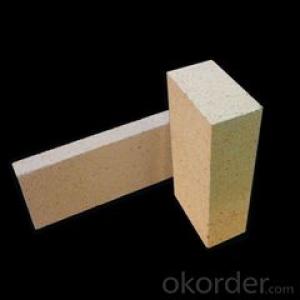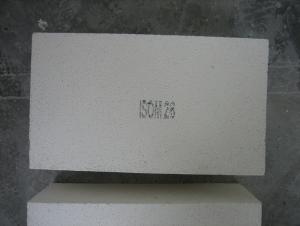Insulating Fire Brick - Refractory Mullite Insulating Refractory Brick JM 25
- Loading Port:
- Shanghai
- Payment Terms:
- TT OR LC
- Min Order Qty:
- 20 m.t.
- Supply Capability:
- 20 m.t./month
OKorder Service Pledge
OKorder Financial Service
You Might Also Like
Okorder series heat insulation brick
Okorder series thermal insulation brick is an effective, energy saving, low carbon, environmental protection advanced, according to the ASTM standard manufacturing products. Okorder series products have all kinds of materials in the field of metallurgy, industrial furnaces, aluminum, the best Li Ning petrochemical and insulation, electric power and glass ceramics. They can be used as part of an insulation or not to melt. Products have been widely used in the following furnace, achieved satisfactory results.
Application of heat preservation brick
Metallurgical Industry: blast furnace, hot blast furnace, heating furnace, etc..
Petrochemical Industry: ethylene cracking furnace, hydrogen furnace, the main furnace, heating furnace, etc..
Ceramic industry: roller kiln, kiln, etc..
Glass industry: glass furnace regenerator, etc.
Carbon industry: carbon furnace, etc..
Aluminum electrolysis industry: aluminum reduction cell, etc.
Other industries: tunnel kiln, shuttle kiln, etc..
Advantages of heat insulation brick
Low thermal conductivity: many air holes will bring good thermal insulation effect, energy saving.
High crushing strength: high crushing strength, volume stability.
Low heat storage: small heat storage, absorb more heat, energy-saving effect is obvious.
Chundu: High-speed Rail, low content of alkali metal impurities.
Accuracy: the size of the brick machining precision, cutting and grinding the special shape, speed up the brick.
Technical Data
ITEM | GJM30 | GJM28 | GJM26 | GJM23 |
Classification Temperature, ℉/℃ | 3000/1650 | 2800/1540 | 2600/1430 | 2300/1260 |
Bulk Density,g/cm³ | ≤1.0 | ≤0.9 | ≤0.8 | ≥0.5 |
Reheating Linear Change, % | ≤0.9 (1550℃,12 h) | ≤0.8 (1510℃,12 h) | ≤0.7 (1410℃,12 h) | ≤0.5 (1230℃,12 h) |
Al2O3 Content, % | ≥75 | ≥65 | ≥55 | ≥45 |
Fe2O3 Content, % | ≤0.5 | ≤0.6 | ≤0.7 | ≤1.0 |
Thermal Conductivity: | ||||
800℃, w/m.k | ≤0.39 | ≤0.37 | ≤0.35 | ≤0.18 |
1000℃, w/m.k | ≤0.43 | ≤0.41 | ≤0.39 | ≤0.20 |
1200℃, w/m.k | ≤0.48 | ≤0.46 | ≤0.43 | --- |
Insulating brick

- Q: Can insulating fire bricks be used in the construction of smelters or foundries?
- Yes, insulating fire bricks can be used in the construction of smelters or foundries. Insulating fire bricks have excellent thermal insulation properties and can withstand high temperatures, making them suitable for lining the walls and floors of smelters or foundries. They help to retain heat, improve energy efficiency, and protect the surrounding structures from extreme temperatures.
- Q: How do insulating fire bricks affect the overall insulation efficiency of a process?
- Insulating fire bricks significantly enhance the insulation efficiency of a process by providing a high level of thermal resistance. These bricks have low thermal conductivity and can withstand high temperatures, effectively minimizing heat transfer and reducing energy loss. This improved insulation helps maintain consistent and controlled temperatures, leading to increased energy efficiency and reduced fuel consumption in various industrial processes.
- Q: Can insulating fire bricks be used for insulation in aluminum smelters?
- Yes, insulating fire bricks can be used for insulation in aluminum smelters. Insulating fire bricks are made from special lightweight materials that have high insulating properties, making them ideal for applications that require high-temperature insulation. Aluminum smelters operate at extremely high temperatures, and insulating fire bricks can effectively withstand and retain the heat, preventing heat loss and improving energy efficiency. Additionally, these bricks are resistant to thermal shock, a common occurrence in smelting processes, which makes them highly suitable for use in aluminum smelters. Insulating fire bricks can also provide a protective barrier, reducing the risk of heat damage to the surrounding structures and equipment. Therefore, using insulating fire bricks for insulation in aluminum smelters can enhance thermal efficiency, reduce energy consumption, and ensure a safe and efficient smelting process.
- Q: What are the bubble bricks?
- The requirements for production conditions are not high. Simple shed to plant products without open storage, warehouse, on the quality of workers is not high.
- Q: Are insulating fire bricks resistant to mold or mildew?
- No, insulating fire bricks are not resistant to mold or mildew.
- Q: Do insulating fire bricks have a high insulating capacity?
- Yes, insulating fire bricks have a high insulating capacity. These bricks are designed to have low thermal conductivity, which helps in reducing heat transfer and maintaining high temperatures in industrial applications such as furnaces and kilns. They provide excellent insulation, making them highly effective in conserving energy and reducing heat loss.
- Q: Can insulating fire bricks be used in the construction of smelters or foundries?
- Yes, insulating fire bricks can be used in the construction of smelters or foundries. Insulating fire bricks have excellent thermal insulation properties and can withstand high temperatures, making them suitable for lining the walls and floors of smelters or foundries. They help to retain heat, improve energy efficiency, and protect the surrounding structures from extreme temperatures.
- Q: Are insulating fire bricks resistant to electrical conductivity?
- Yes, insulating fire bricks are resistant to electrical conductivity.
- Q: How do insulating fire bricks affect the overall cost of a project?
- The overall cost of a project can be greatly affected by insulating fire bricks, both in terms of immediate expenses and long-term savings. Despite their higher upfront cost compared to traditional bricks, insulating fire bricks offer superior insulation properties, resulting in substantial cost savings over time. Retaining heat and preventing heat transfer are among the primary advantages of insulating fire bricks. This leads to reduced energy consumption and lower utility bills, as less energy is needed to heat or cool a space. In industrial settings, insulating fire bricks can optimize the efficiency of furnaces, kilns, and other high-temperature equipment, resulting in increased productivity and lower operational costs. Furthermore, insulating fire bricks provide excellent thermal insulation, creating a stable and comfortable indoor environment. This is particularly beneficial in residential and commercial construction, as it reduces reliance on heating and cooling systems, further reducing energy consumption and associated costs. In addition to their insulation properties, insulating fire bricks are highly durable and resistant to high temperatures, chemical corrosion, and mechanical stress. This durability minimizes the need for frequent repairs or replacements, leading to long-term cost savings. Their lightweight nature also makes them easy to handle and install, potentially reducing labor costs during construction. Moreover, insulating fire bricks have a longer lifespan compared to traditional bricks, resulting in lower maintenance and replacement costs over time. Their ability to withstand extreme temperatures and harsh environmental conditions means they are less likely to deteriorate or require frequent repairs. In conclusion, despite their higher initial cost, insulating fire bricks offer superior insulation properties, energy efficiency, durability, and reduced maintenance needs, leading to significant cost savings throughout a project's lifespan. When evaluating the overall cost-effectiveness of using insulating fire bricks in a construction or industrial project, it is important to consider the long-term benefits and potential energy savings.
- Q: Can insulating fire bricks be used as a refractory material?
- Yes, insulating fire bricks can be used as a refractory material. Insulating fire bricks are specifically designed to withstand high temperatures and thermal shock, making them suitable for applications that require heat insulation and refractory properties. They have low thermal conductivity, which helps to reduce heat loss and conserve energy. Insulating fire bricks are commonly used in various industries, including steel, glass, ceramics, and petrochemicals, where they are used as lining materials in furnaces, kilns, ovens, and other high-temperature equipment. Their ability to withstand extreme temperatures, coupled with their insulating properties, makes them an excellent choice for refractory applications.
Send your message to us
Insulating Fire Brick - Refractory Mullite Insulating Refractory Brick JM 25
- Loading Port:
- Shanghai
- Payment Terms:
- TT OR LC
- Min Order Qty:
- 20 m.t.
- Supply Capability:
- 20 m.t./month
OKorder Service Pledge
OKorder Financial Service
Similar products
Hot products
Hot Searches
Related keywords






























